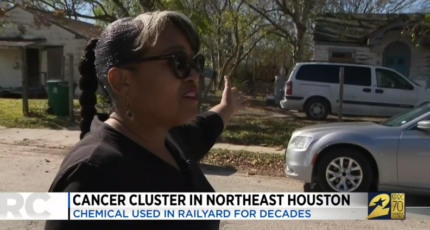
Over 6.7 million Black Americans live in the in the 91 counties with oil refineries. (Photo by Mark Ralston/AFP/Getty Images)Environmental Pollution Is Hurting Low-Income Black Communities the Most, Study Shows
Black Americans are at higher risk of developing pollution-related health problems caused by the locations of oil and gas refineries, according to a new report.
The analysis, a collaboration between the NAACP and nonprofit advocacy group Clean Air Task Force, found that many African-American communities face serious health risks as a result of toxic pollution from industrial plants that are often located just blocks away. For one, over 1 million Black Americans live within a half mile of existing natural gas facilities, and that number stands to grow.
“African-American and other environmental justice communities face heavy burdens because of the millions of pounds of hazardous emissions released by the oil and gas industry each year,” read the report, titled “Fumes Across the Fence-Line.”
“These life–threatening burdens placed on communities of color near oil and gas facilities are the result of systemic oppression perpetuated by the traditional energy industry, which exposes communities to health, economic and social hazards,” it continued.
Residents living in what the report calls “fence-line communities” also face an elevated risk of developing cancer, asthma and other respiratory health issues caused by toxic emissions, the study showed. Though oil and gas refineries are often located near fences and property lines in low-income communities, their hazardous fumes can drift far and wide.
The report showed that Louisiana and Texas have the largest populations of Black folks living in areas where cancer risk exceeds the Environmental Protection Agency’s level of concern, while Black Americans living in Dallas-Fort Worth and Atlanta faced the highest risk of asthma attacks caused by ozone smog attributable to oil and gas pollution. Texas, Ohio and California also had the biggest share of Black people living in the threat radius,” an area within a half-mile of active oil and gas facilities.
According to NBC BLK, the concerning new study comes as world leaders meet in Germany to discuss recent progress in battling climate change. Democratic lawmakers and advocacy groups also met on Capitol Hill Tuesday, Nov. 14, to talk about the report’s findings and the impact of climate change on nonwhite communities.
Local leaders like Rev. Lennox Yearwood criticized President Donald Trump for withdrawing the U.S. from the Paris Climate Agreement earlier this year and axing the Clean Power Plan.
“Communities of color cannot wait any longer for the Trump Administration to address climate change,” said Yearwood, President & CEO of the Hip Hop Caucus. “From Katrina, Sandy, Standing Rock, Harvey, Irma, to Maria, climate change’s devastating impacts are here now. The solutions exist, and it’s time to act. Climate change is not a game; it is a matter of life and death for our communities.”
Speaking to NBC News, Rep. Al Green (D-Texas), said that while fellow legislators and activists have been fighting environmental racism for years, it has been difficult to gain traction. He pointed to the “enormous amount of influence” wielded by powerful energy companies who build in minority communities, noting that locals often do not have the resources to fight back or move somewhere else.
Other key findings from the NAACP/Clean Air Task Force report include:
- Over 6.7 million Black Americans live in the 91 U.S. counties with oil refineries.
- The air in many Black communities violates the EPA’s air quality standards for ozone smog.
- African-American children are burdened by 138,000 asthma attacks and 101,000 lost school days per year due to ozone smog.


